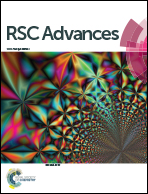Sn–P–F containing glass matrix for the fabrication of phosphor-in-glass for use in high power LEDs†
Abstract
In this study, we introduce a low-melting-point (MP) glass ceramic (GlaC) material which can be used to fabricate a phosphor-in-glass (PiG) with Y3Al5O12:Ce3+ (YAG) phosphor for the realization of high-power white-light-emitting diodes (WLEDs). PiG using a low-MP Sn–P-rich GlaC material, with simple fabrication at 230 °C, can address the drawbacks of the phosphor thermal degradation of currently developed PiGs with a high MP of more than 400 °C, and the yellowing of commercialized phosphor-in-silicon binder (PiSB) materials. In addition, the low-MP PiG can serve as a heat sink due to its good thermal conductivity and good stability compared to those of commercialized PiSB materials. The optical properties of a low-MP PiG-based WLED are a luminous efficacy (LE) of 118 lm W−1, an external quantum efficiency (EQE) of 0.33 and a color-rendering index (CRI) of 68 at 4275 K at an applied current of 350 mA. The simply fabricated and stable PiG-based WLED using the low-MP GlaC material will be a competitive candidate in the WLED lighting market.


 Please wait while we load your content...
Please wait while we load your content...